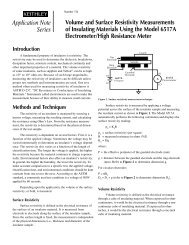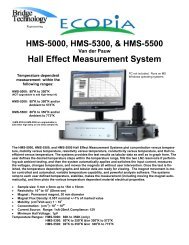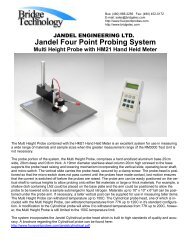P/N Typing Unit - Four Point Probes
P/N Typing Unit - Four Point Probes
P/N Typing Unit - Four Point Probes
You also want an ePaper? Increase the reach of your titles
YUMPU automatically turns print PDFs into web optimized ePapers that Google loves.
Bus: (480) 988-2256 Fax: (480) 452-0172E-mail: sales@bridgetec.comhttp://www.fourpointprobes.comhttp://www.bridgetec.comJANDEL Engineering LtdModel PN01P/N <strong>Typing</strong> <strong>Unit</strong>The Jandel model PN01 P/N <strong>Typing</strong> <strong>Unit</strong> plugs into a standardfour point probe to determine whether a material is Ptype or N type. It uses the rectification method as describedon page 2. The PN01 can be connected to an existing Jandelfour point probe stand or it can plug into a hand heldprobe head. An AC adaptor is included.Operating instructions:1) Plug the AC adaptor into the back of the PN01 <strong>Typing</strong><strong>Unit</strong>. Once powered up, the “READY” light should beilluminated.2) Plug the four point probe unit into the 5 pin DIN connectorlocated in the back of the PN01 as show here:5 pin DIN connectorfrom probe unit plugsinto female 5 pin DINconnector hereThe universal AC adaptorplugs in here3) Lower the probe into contact and press the “TEST/Clear” button. Either the “P-Type” or “N-Type” lightshould illuminate, indicating type. If neither of thelights illuminates, it could be a contact issue, or it maybe that the PN01 is not capable of measuring that particularmaterial. Usually a probe with relatively sharptips (40 micron radii) and strong springs (200 gramsper tip) works best at measuring various materials.Using the rectification method, lower resistance materialsare not as easily measured for P/N type as arehigher resistance materials. The PN01 sits flat withthe back slightly thicker than the front so that it is angledtowards the user. Dimensions are 5" x 5.5"The Jandel Cylindrical probe fitted with the small nosepieceshroud can be used with the PN01 to make a complete systemThe PN01 can be used with the Multi Height Probe orwith any of the various Jandel probe models.
Determining Conductivity Type of a Semiconductor MaterialThere are several methods for determining conductivity type. The rectification method is used onhigh resistivity material; the thermoelectric method is used on low resistivity materials. Both methodsinvolve using a four-point collinear probe, an AC current source, and a DC voltmeter. The JandelPN01 P/N <strong>Typing</strong> <strong>Unit</strong> uses the rectification method.The Rectification Method involves determining the sign of the majority carrier based on the polarity of arectified AC signal at the point of contact with the semiconductor material. The image shown belowillustrates this setup. When the four point collinear probe comes in contact with the wafer, a metalsemiconductor “diode” is created at the interface between each probe and the wafer. An AC current issourced between the first two probes and a DC voltmeter is used to sense the polarity of the voltagebetween probes 2 and 3. The metal-semiconductor Schottky “diode” at probe 2 will be either forwardorreversed biased depending on the polarity of the current as well as the conductivity type. Asa result, the voltmeter will read a positive voltage for p-type material and a negative voltage for n-typematerial.
















